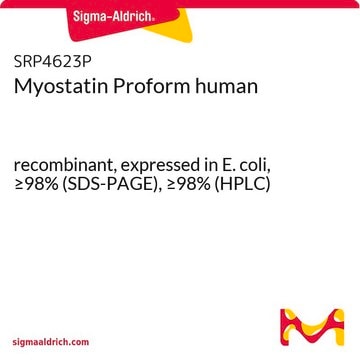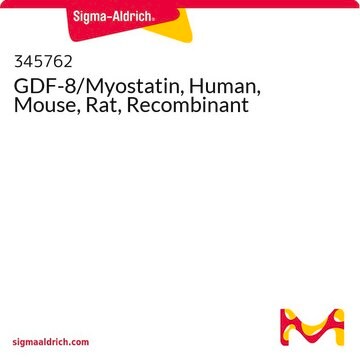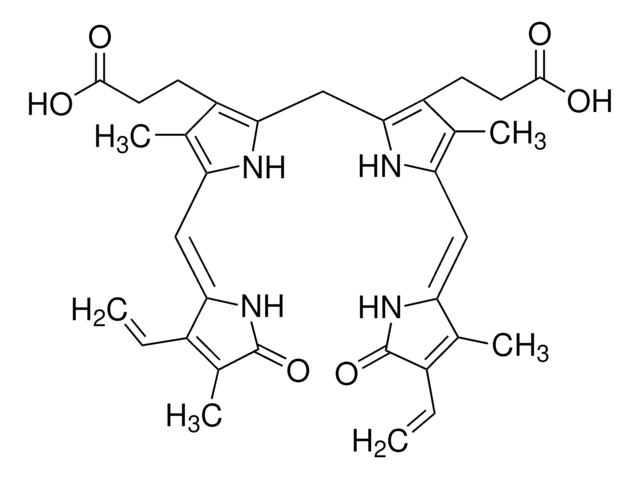M3064
Myostatin human
recombinant, expressed in E. coli, lyophilized powder, suitable for cell culture
Synonym(s):
GDF-8, Growth Differentiation Factor - 8
Sign Into View Organizational & Contract Pricing
All Photos(1)
About This Item
Recommended Products
biological source
human
Quality Level
recombinant
expressed in E. coli
Assay
≥95% (SDS-PAGE)
form
lyophilized powder
mol wt
16 kDa (including a 31 amino-acid spacer and 6-His tag)
packaging
pkg of 0.1 mg
technique(s)
cell culture | mammalian: suitable
UniProt accession no.
storage temp.
−20°C
Gene Information
human ... MSTN(2660)
Application
Use recombinant myostatin to study its mechanisms of action in vitro.
Biochem/physiol Actions
Myostatin is a 25 KDa, homodimer, that acts on muscle to induce SMAD family transcription factors such as SMAD2 and SMAD3. It inhibits the differentiation of myoblasts into mature muscle fibers. Positive control for myostatin in Western blots and ELISA.
Positive control for myostatin in Western blots and ELISA.
Storage Class Code
11 - Combustible Solids
WGK
WGK 3
Flash Point(F)
Not applicable
Flash Point(C)
Not applicable
Personal Protective Equipment
dust mask type N95 (US), Eyeshields, Gloves
Certificates of Analysis (COA)
Search for Certificates of Analysis (COA) by entering the products Lot/Batch Number. Lot and Batch Numbers can be found on a product’s label following the words ‘Lot’ or ‘Batch’.
Already Own This Product?
Find documentation for the products that you have recently purchased in the Document Library.
Karima Relizani et al.
Molecular therapy : the journal of the American Society of Gene Therapy, 22(8), 1423-1433 (2014-05-28)
Myostatin regulates skeletal muscle size via the activin receptor IIB (ActRIIB). However, its effect on muscle energy metabolism and energy-dependent muscle function remains largely unexplored. This question needs to be solved urgently since various therapies for neuromuscular diseases based on
H Takahashi et al.
Domestic animal endocrinology, 48, 62-68 (2014-06-08)
The purpose of this study was to determine whether myostatin alters glucose transporter-4 (GLUT4) expression in bovine skeletal muscles and myoblasts isolated from double-muscled (DM) and normal-muscled (NM) Japanese Shorthorn cattle. Plasma concentrations of glucose were lower in DM cattle
Qiang Zhang et al.
The FEBS journal, 277(2), 466-476 (2009-12-18)
The ubiquitin ligase RING finger protein 13 gene (RNF13) was first identified in a screen for genes whose expression is regulated by myostatin in chicken fetal myoblasts. In this study, we demonstrate that the RNF13 gene is broadly expressed in
R E Ferrell et al.
Genomics, 62(2), 203-207 (1999-12-28)
Myostatin is a recently identified member of the transforming growth factor-beta family of regulatory factors, also known as growth and differentiation factor 8 (GDF8). The nucleotide sequence of human myostatin was determined in 40 individuals. The invariant promoter contains a
Yutaka Ohsawa et al.
PloS one, 10(7), e0133713-e0133713 (2015-08-01)
Myostatin, a muscle-specific transforming growth factor-β (TGF-β), negatively regulates skeletal muscle mass. The N-terminal prodomain of myostatin noncovalently binds to and suppresses the C-terminal mature domain (ligand) as an inactive circulating complex. However, which region of the myostatin prodomain is
Our team of scientists has experience in all areas of research including Life Science, Material Science, Chemical Synthesis, Chromatography, Analytical and many others.
Contact Technical Service








